In today’s comparison, I have decided to confront two minimalistic air purifiers that, at first sight, seem so opposite. Yet, the reality is entirely different. Both Blueair 411 and TruSens Z-1000 have more in common than expected.
Of course, not everything is about looks, but sometimes good looks can really close the deal. With regards to gadgets and appliances, having an appealing outer shell can be a determining factor for some users.
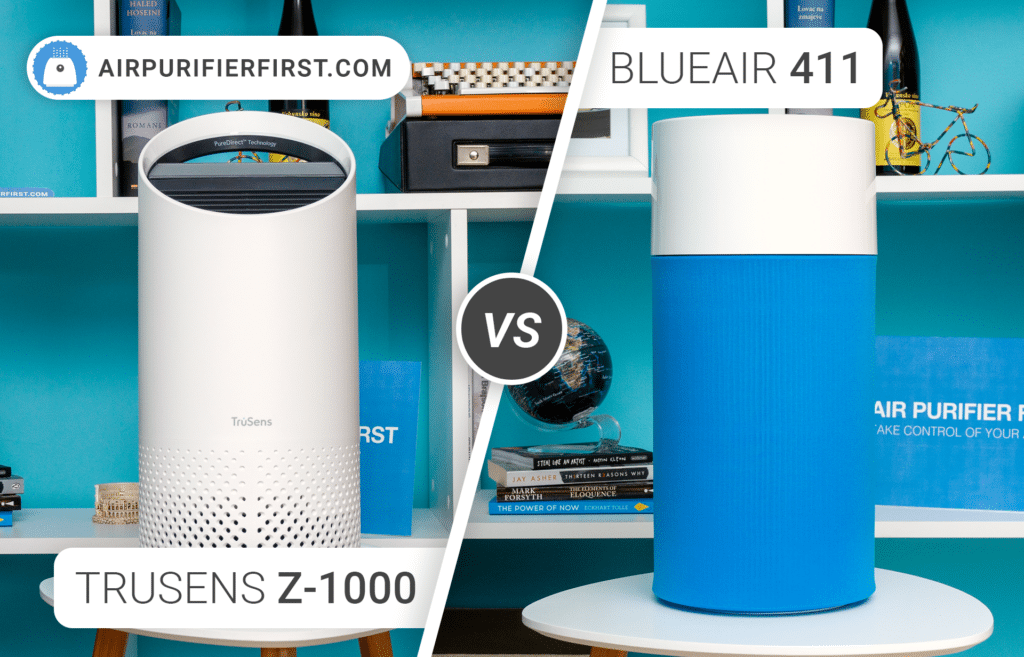
Table of Contents
With that in mind, producers of both air purifiers have done a great job, respectively. Although, in my opinion, TruSens does have a bit more elegant look and higher quality of the production material. You can feel it at first touch. I also like the fact that it’s available in both white and black color, making it more adaptable to any interior. The producer promises it will fit your lifestyle, and I agree.
On the other hand, Blueair 411 comes with an innovative pre-filter available in 5 different colors, making it easier to adapt to any living space style. If you get bored by the color, simply undress the air purifier and pull on a new color pre-filter.
As for the room coverage, TruSens Z-1000 promises to cover up to 250 sq. ft. space, while Blueair 411 can handle up to 161 sq. ft. Still, keep in mind that these are only numbers provided by the manufacturers or user manuals. In reality, Blueair 411 has far better CADR than TruSens.
To provide you with a detailed and enjoyable comparison, I will do my best to cover all available features, making it easier to make a final purchasing decision.
TruSens Vs Blueair Specifications
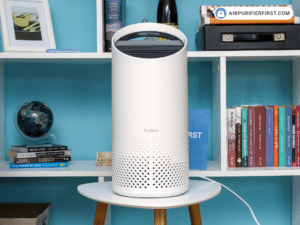 |
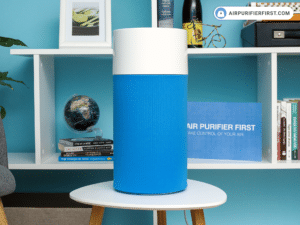 |
|
| Manufacturer | TruSens | Blueair |
| Model | Z-1000 | 411 |
| Dimensions | 7.7 x 7.7 x 17.9 inches | 16.7 x 7.8 x 7.8 inches (42,5 x 20 x 20 cm) |
| Room Coverage (4.8 ACH) | 250 sq. ft. | 161 sq. ft. |
| Performance Ratings | ||
| Filtration Technology | Carbon Pre-filter, HEPA Filter and UV-C Light | Washable Pre-filter, Particle Filter, and Carbon Filter |
| Filter Replacement Indicator | Yes | Yes |
| Filter Longevity | 12-15 months | 6-8 months |
| Power | 40W | 10W |
| Operating Costs Ratings | ||
| Fan Speeds | 3 – Speed 1, Speed 2, and Speed 3 | 3 – Speed 1, Speed 2, and Speed 3 |
| Air Quality Sensor | No | No |
| UV-C Light | Yes | No |
| Noise Levels | 43.8 – 64.4 dBA | 40.6 – 67.5 dBA |
| Noise Ratings | ||
| Warranty | 2-year | 2-year |
| In-Depth Review | TruSens Z-1000 | Blueair 411 |
| Price | Check Price on Amazon | Check Price on Amazon |
Features Overview
Speaking of the advanced features that each of these air purifiers is equipped with, I can immediately set aside the Blueair 411. This is altogether a minimalistic air purifier, with only one control button with practically no advanced options to brag about.
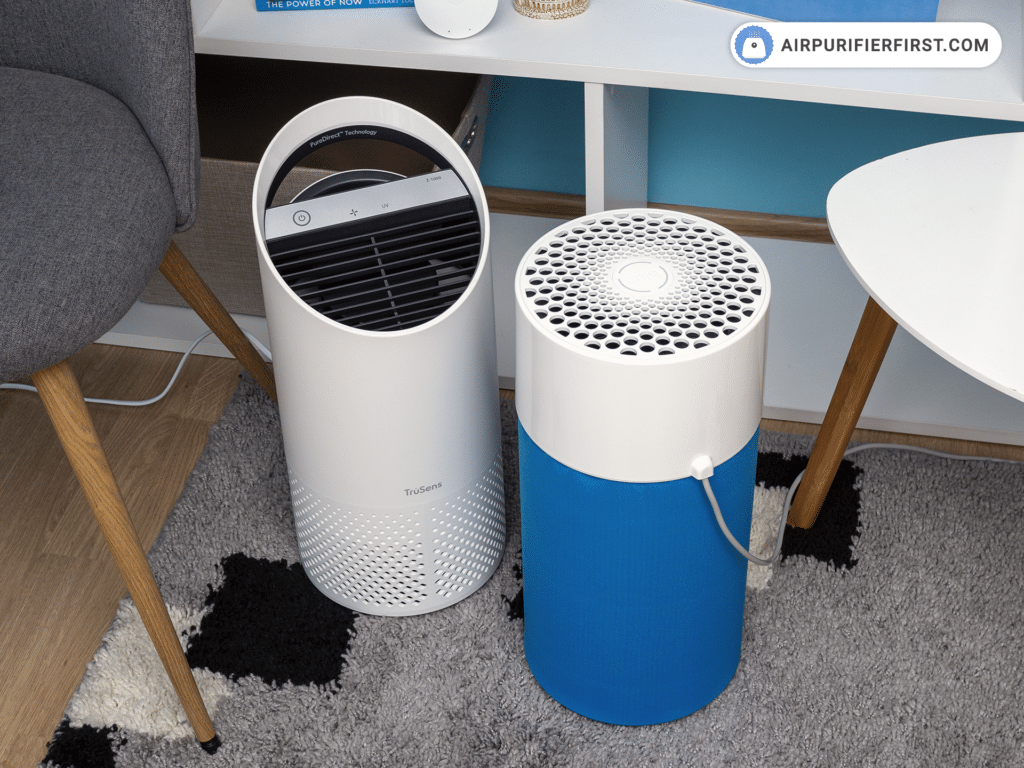
Contrary to Blueair, one would expect that TruSens air purifier comes overloaded with features, but that is not the case. There aren’t any special advantageous features, but there are quite some buttons if you’re the type that likes to try every single one.
Filter Reset Indicator
One of the main things in common is the Filter Reset Indicator, a specially designed feature that provides you with a notice of filter replacement, and it will do it at the right time.
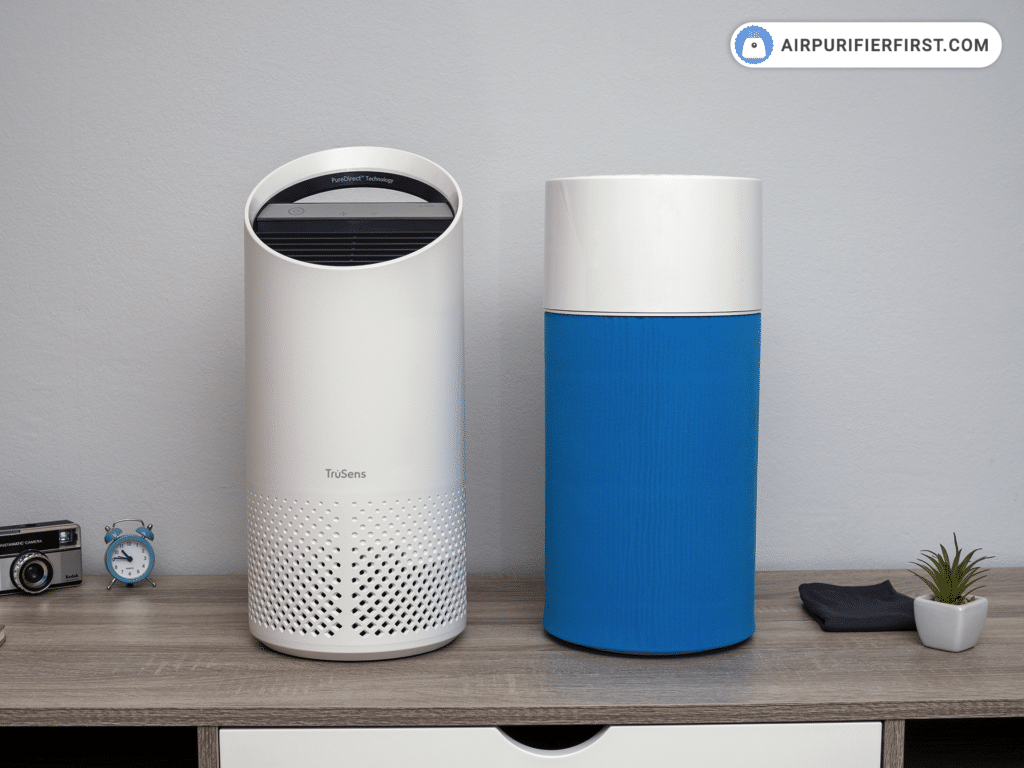
The TruSens can show off with two Indicators, one for the HEPA filter and the other for the carbon filter. Since these filters don’t have the same duration limit, both indicators light up at separate times.
Blueair 411 has one and only Filter Reset Indicator located right next to the control button. If you see a yellow-colored indicator, brace yourself because your filters are about to expire. Once it turns red, there isn’t much time left, and you should replace the filters as soon as possible.
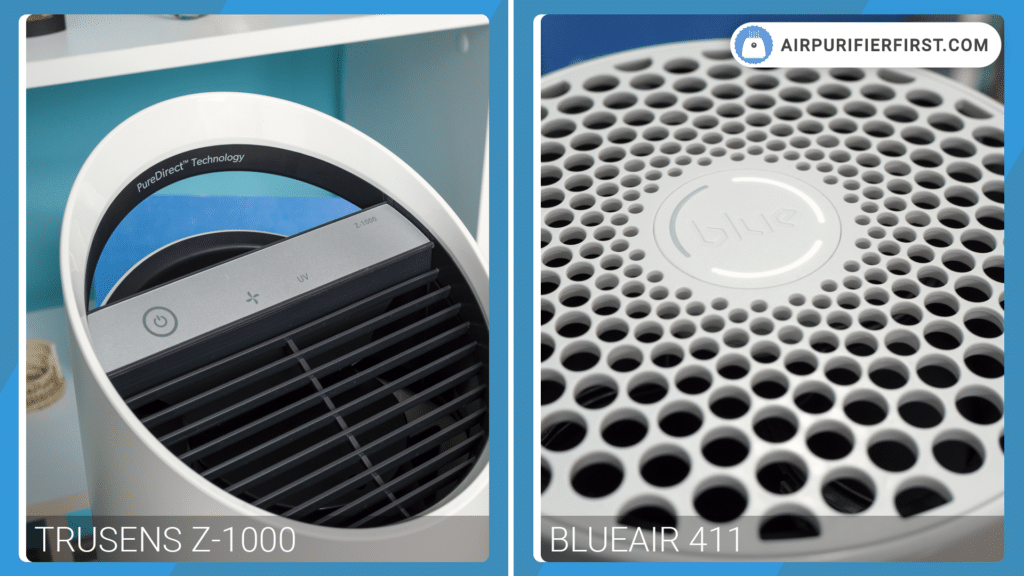
Bear in mind the Blueair’s 411 washable pre-filter, which does not need to be replaced.
Changeable Pre-filter
As mentioned previously, TruSens Z-1000 does not have the option to wash or swap the pre-filter. This privilege is reserved for Blueair 411 only. The pre-filter is basically a fabric that you can pull ON and OFF from the bottom part of an air purifier. You can do it whenever you wish to clean it deeply, or simply change the appearance of your appliance. With this option, you won’t have to buy a new one almost at no time, unless you really need to.
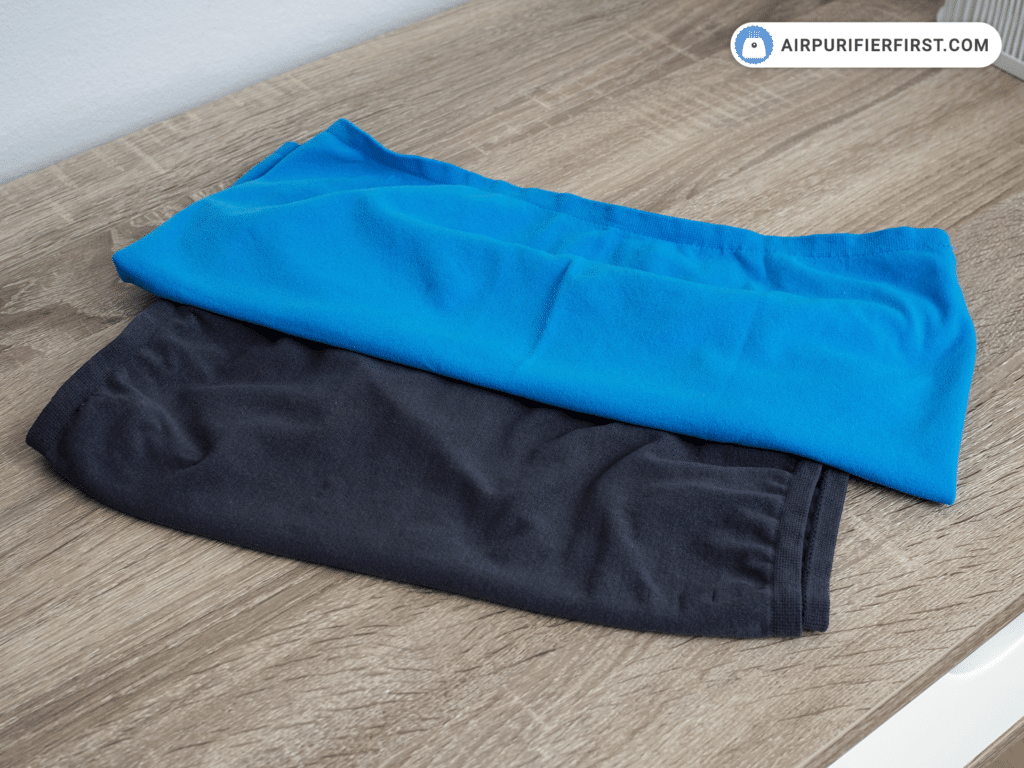
Needless to mention how adaptable Pre-filter makes the Blueair 411 into almost any room layout and style.
Airflow
Regarding which air purifier has better airflow, I must begin with the obvious notion of a cylindrical shape of both air purifiers.
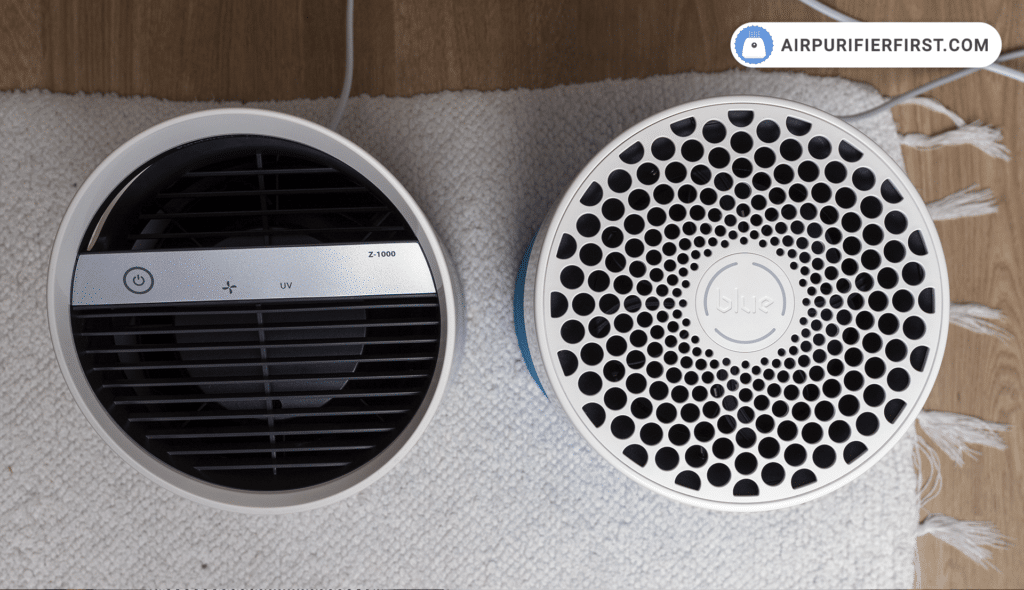
TruSens has filters located on the bottom part, all around the device. This means a 360-degree filtration of captured pollutants, whereas the clean air gets dispersed into two air streams throughout the room.
Compared to filters that only take a quarter part of the TruSens, Blueair’s filters take two-thirds of the surface. Filters are located at the bottom part of the appliance, also in 360 degrees. Once the allergens, viruses, and other pollutants get trapped, the air gets filtered and dispersed through the upper holes with vertical airflow.
Warranty
When deciding on which appliance to buy, one of the things you have to check is most definitely the warranty coverage. In this case, both air purifiers are covered with a 2-year warranty.
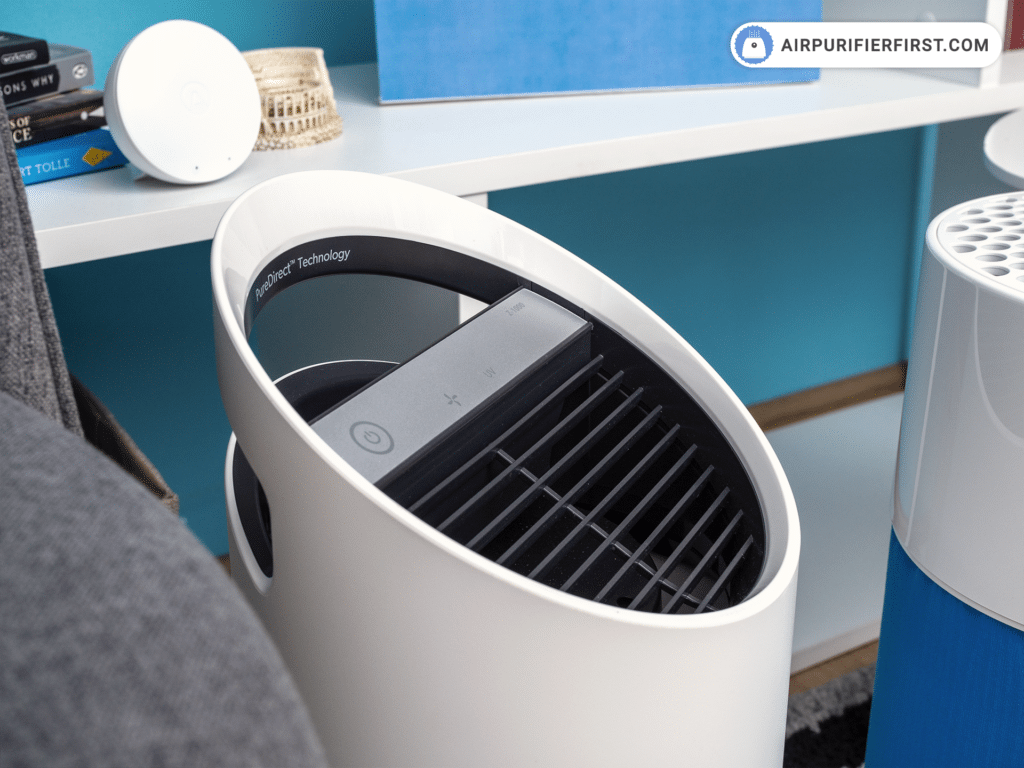
The only difference is that with the TruSens, you get two years straight from the beginning, while Blueair’s manufacturer gives you only one year plus an additional year if you register on their website straight upon the purchase.
Filtration Technology
Having a three-stage filtration is another thing these air purifiers have in common. However, there is a significant difference in the filters they use. TruSens Z-1000 uses a Carbon Pre-filter, a HEPA filter, and a UV-C Light, while Blueair 411 has a Washable Pre-filter and a Particle plus Carbon filter.
With both air purifiers being cylindrically shaped, filters are designed to follow that shape.
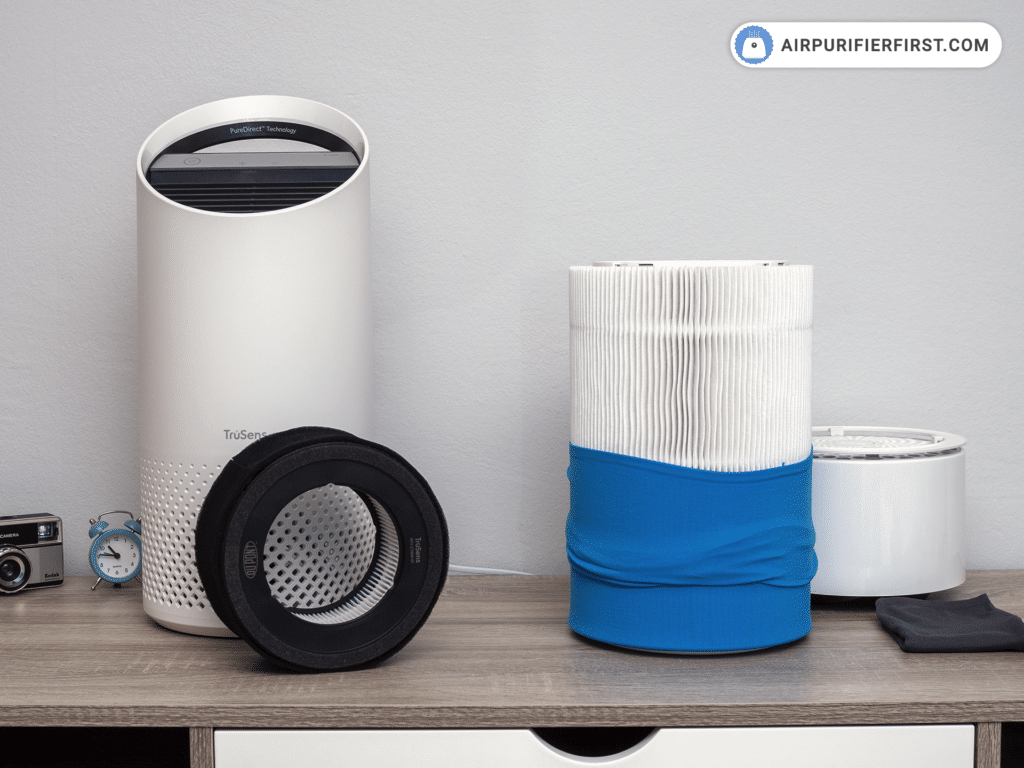
A pre-filter is the first stage of filtration for Blueair 411 and TruSens Z-1000 but with a slight contrast. Blueair uses a washable fibrous filter, while TruSens has a carbon filter.
For the second filtration stage, Blueair 411 uses a particle filter contrary to the HEPA filter used by the TruSens. Not one of these air purifiers uses True HEPA technology, and it’s a pity they don’t.
The third filtration stage belongs to the UV-C Light in Tru Sens Z-1000. This Light can be switched on/off by a simple finger hold on a UV button in the Control Panel.
As for the last filtration stage, Blueair 411 uses a fibrous carbon filter. I do have to mention that Blueair 411 has a HEPAsilent technology installed by default that can’t be turned off. From this point of view, it can be considered the fourth stage of filtration.
From what I could see, none of the carbon filters installed in both devices have shown results that would impress me at all. Especially, I have to say how inefficient these filters turned out to be in neutralizing the odors from the room. The only good thing is that with TruSens you get to purchase additional pellets-based carbon filters, which are far better than the fibrous ones.
How To Replace Filter On Both These Devices?
Judging by the manufacturers’ instructions, with TruSens air purifier, you get to change the filters every 12-15 months, whereas Blueair 411 cuts the period in half by giving six to eight months at most. In reality, TruSens has a really small filter that gets dirty pretty easily, which means you will have to replace it far more than recommended.
What I can recommend to you is to pay attention to the regular maintenance of each air purifier’s filters. Especially the pre-filters. Need I remind you that Blueair has a washable one and that TruSens only needs simple vacuuming?
Noise Test
To make the picture clearer, both Blueair 411 and TruSens Z-1000 have three-speed levels and no Sleep Mode option. To be true, this made my comparative tests a lot easier regarding the noise they produce.
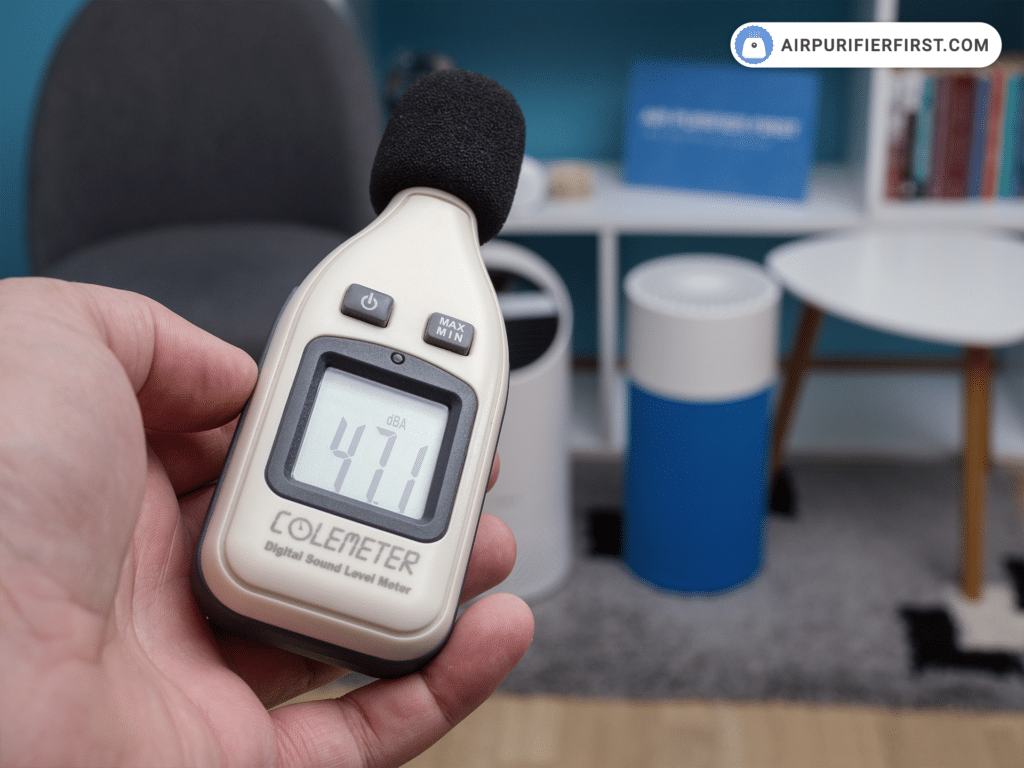
Even though I personally like the Sleep Mode, I have to admit Blueair turned out to be more silent while at first speed than many other air purifiers are on Sleep Mode.
| Product | Noise Range (dBA) |
|---|---|
| TruSens Z-1000 | 43.8 – 64.4 dBA |
| Blueair 411 | 40.6 – 67.5 dBA |
When I put them on top speed, I was overwhelmed by the noise both Blueair 411 and TruSens Z-1000 produced. It was almost impossible to be in the same room with any of these devices.
While running, the motor of TruSens turns out as well optimized and with comfortable sound. I didn’t notice any crackling or annoying sound at all.
On the other hand, Blueair also has a well-optimized motor, but only while running on the first and the second speed. The third speed got the motor buzzing, and I didn’t like the sound of it.
Performance Tests
While doing tests on any air purifier, I tend to do it in various room sizes just to make sure the result is realistic. But, while comparing two air purifiers, I have to provide the same conditions. That is why, for today’s comparison, I picked two room sizes to see how Blueair 411 and TruSens Z-1000 manifest their characteristics.
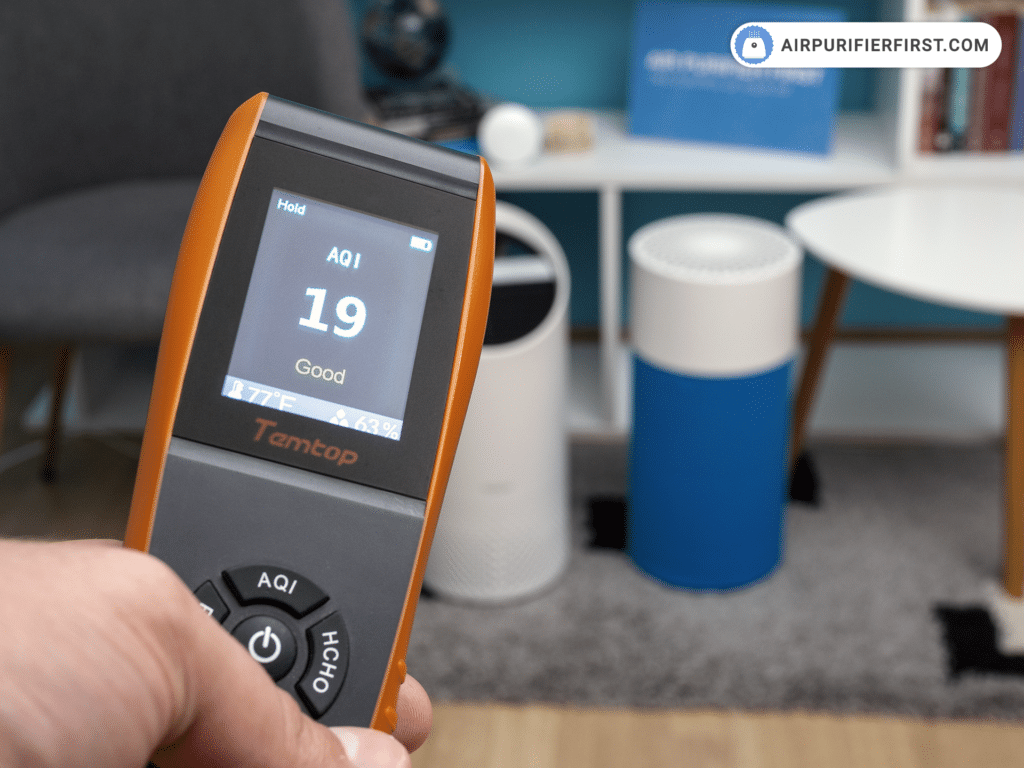
I hope it won’t be a spoiler alert if I tell you that I was impressed and very pleased with the results. Yet, my biggest reproach was poor gas neutralization.
Let’s see the results.
194 sq. ft. Room Tests
When I mentioned the same conditions provided, I meant that both air purifiers were left running for 60 minutes on top speed level.
In a 194 sq. ft. room, Blueair 411 and TruSens Z-1000 have managed to improve the air quality by 95% and 93% accordingly. This is an amazing result, and I wouldn’t mind having any of these air purifiers in this, per se, smaller bedroom size.
194 sq. ft. Room
* Data measuring time is 60 minutes.
320 sq. ft. Room Tests
While still working in the same conditions as in the previous test, in a 320 sq. ft. room TruSens has managed to beat the Blueair 411 with 91% as opposed to Blueair’s 90% cleaner air.
320 sq. ft. Room
* Data measuring time is 60 minutes.
As you can see, the results are more than satisfying, and no wonder users have nothing but praise to share about both air purifiers.
Operating Costs
With a 40W motor power, TruSens turns out to be a four times greater energy consumer than Blueair with its 10W powerful motor.
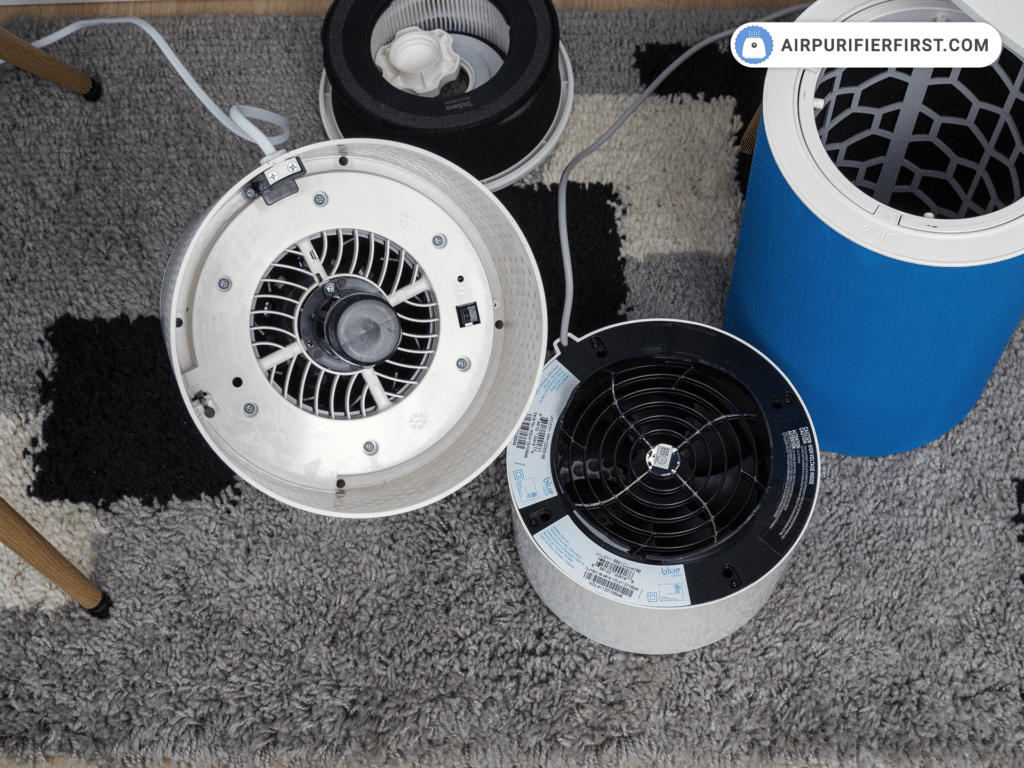
If you leave both devices running 24/7 for a whole month while on top speed, you will end up with less than 1$ electricity bill in the case of the Blueair, and with around 3.6$ more than usual if you use TruSens air purifier. The obvious from this test is that TruSens Z-1000 spends far more energy than Blueair 411.
| Product | Wattage Range (W) |
|---|---|
| TruSens Z-1000 | 0.2 – 41.2W |
| Blueair 411 | 0.3 – 7.6W |
After putting filter replacement and electricity consumption costs into the equation, it is evident that Blueair 411 is a lot more affordable in terms of annual maintenance.
TruSens Z-1000 Vs Blueair 411 Video Comparison
Which One Does It Better?
With almost identical results in various conducted tests, both Blueair 411 and TruSens Z-1000 have shown us that they are more alike than we thought at first.
Regarding all differences and similarities, I still have to make a final decision which, in this case, goes in favor of Blueair 411. The crucial features that turned the game in favor of Blueair were significantly lower power consumption, washable pre-filter, and a little bit better performance.
If you still wish to buy a TruSens air purifier, you have my full support because I honestly think that this air purifier can never be a bad choice. It will do more good to your health than you can imagine.
I hope I’ve made your decision easier, but keep me informed if there is anything else you would like to discuss on the matter. The comments section is right down below.
Leave a Reply